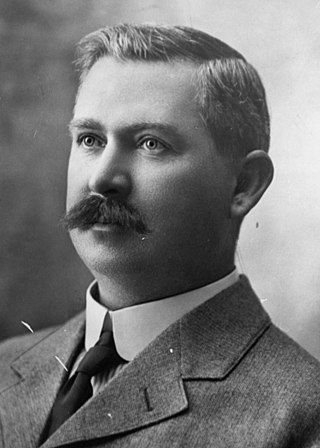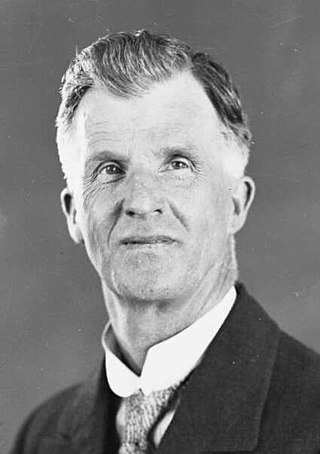| ||||||||||
| ||||||||||
| ||||||||||
The Australian Labor Party held a leadership election on 16 May 1922, following the death of Frank Tudor. The party elected Matthew Charlton as its new leader.
| ||||||||||
| ||||||||||
| ||||||||||
The Australian Labor Party held a leadership election on 16 May 1922, following the death of Frank Tudor. The party elected Matthew Charlton as its new leader.
Tudor died on 10 January 1922, after a long period of ill health. He had been the party's leader since November 1916, following the expulsion of Billy Hughes and his supporters during the split over conscription. His deputy and assumed successor, T. J. Ryan, had died a few months earlier on 1 August 1921. [1] Matthew Charlton, who had already acted as deputy leader on several occasions, [2] was formally chosen as Ryan's replacement on 29 September. [3] He served as acting leader on a number of occasions when Tudor's health forced his absence. [1]
On 25 January, following Tudor's state funeral, Charlton was chosen unanimously as leader of the Labor Party in the House of Representatives. He thus became Leader of the Opposition. [4] [5] The overall leadership of the party was left vacant until parliament resumed, but Charlton was the de facto party leader. On 16 May, the party formally elected Charlton as its leader. [6] Albert Gardiner, the party's sole senator, was the only other candidate, attracting only 2 votes to Charlton's 22. [7] He was subsequently elected unopposed as the party's deputy leader, while Frank Anstey was chosen as the deputy leader in the House of Representatives. James Scullin was also nominated for the latter post, despite only having recently returned to parliament, but he declined the nomination. [8]
The following table gives the ballot results:
| Name | Votes | Percentage | |
|---|---|---|---|
| Matthew Charlton | 22 | 91.66 | |
| Albert Gardiner | 2 | 8.34 | |

The Australian Labor Party (ALP), also simply known as Labor, is the major centre-left political party in Australia and one of two major parties in Australian politics, along with the centre-right Liberal Party of Australia. The party has been in government since being elected at the 2022 federal election, and with political branches in each state and territory, they currently form government in New South Wales, Queensland, South Australia, Victoria, Western Australia, the Australian Capital Territory, and the Northern Territory. As of 2023, Tasmania is the only state or territory where Labor forms the opposition. It is the oldest continuous political party in Australian history, being established on 8 May 1901 at Parliament House, Melbourne, the meeting place of the first federal Parliament.

The Nationalist Party, also known as the National Party, was an Australian political party. It was formed in February 1917 from a merger between the Liberal Party and the National Labor Party, the latter formed by Prime Minister Billy Hughes and his supporters after the 1916 Labor Party split over World War I conscription. The Nationalist Party was established as a 'united' non-Labor opposition that had remained a political trend once the Labor party established itself in federal politics. The party was in government until electoral defeat in 1929. From that time it was the main opposition to the Labor Party until it merged with pro-Joseph Lyons Labor defectors to form the United Australia Party (UAP) in 1931. The party is a direct ancestor of the Liberal Party of Australia, the main centre-right party in Australia.

Francis Michael Forde was an Australian politician who served as the 15th prime minister of Australia from 6 to 13 July 1945. He was deputy leader of the Australian Labor Party from 1932 to 1946 and served as prime minister in a caretaker capacity following the death of John Curtin. He is the shortest-serving prime minister in Australia's history.

Francis Gwynne Tudor was an Australian politician who served as the leader of the Australian Labor Party from 1916 until his death. He had previously been a government minister under Andrew Fisher and Billy Hughes.

The deputy prime minister of Australia is the deputy chief executive and the second highest ranking officer of the Australian Government. The office of deputy prime minister was officially created as a ministerial portfolio in 1968, although the title had been used informally for many years previously. The deputy prime minister is appointed by the governor-general on the advice of the prime minister. When Australia has a Labor government, the deputy leader of the parliamentary party holds the position of deputy prime minister. When Australia has a Coalition government, the Coalition Agreement mandates that all Coalition members support the leader of the Liberal Party becoming prime minister and the leader of the National Party becoming the deputy prime minister.
The Liberal Party was a parliamentary party in Australian federal politics between 1909 and 1917. The party was founded under Alfred Deakin's leadership as a merger of the Protectionist Party and Anti-Socialist Party, an event known as the Fusion.

The Liberal–National Coalition, commonly known simply as the Coalition or the LNP, is an alliance of centre-right political parties that forms one of the two major groupings in Australian federal politics. The two partners in the Coalition are the Liberal Party of Australia and the National Party of Australia. Its main opponent is the Australian Labor Party (ALP); the two forces are often regarded as operating in a two-party system. The Coalition was last in government from the 2013 federal election until the 2022 Australian federal election. The group is led by Peter Dutton, who succeeded Scott Morrison after the 2022 Australian federal election.

Sir Eric Archibald Willis was an Australian politician, Cabinet Minister and the 34th Premier of New South Wales, serving from 23 January 1976 to 14 May 1976. Born in Murwillumbah in 1922, Willis was educated at Murwillumbah High School and the University of Sydney, where he obtained a Bachelor of Arts with double honours. Enlisting during World War II, Willis served on the homefront and later served in New Guinea and the Philippines. He continued to serve the Citizen Military Forces until 1958.

The leader of the Australian Labor Party is the highest political office within the federal Australian Labor Party (ALP). Leaders of the party are chosen from among the sitting members of the parliamentary caucus either by members alone or with a vote of the party’s rank-and-file membership. The current leader of the Labor Party, since 2019, is Anthony Albanese, who has served as the prime minister of Australia since 2022. There have been 21 leaders since 1901 when Chris Watson was elected as the inaugural leader following the first federal election.
The New South Wales Labor Party, officially known as the Australian Labor Party (New South Wales Branch) and commonly referred to simply as NSW Labor, is the New South Wales branch of the Australian Labor Party (ALP). The branch is the current ruling party in the state of New South Wales and is led by Chris Minns, who has served concurrently as premier of New South Wales since 2023.

Thomas Joseph Ryan was an Australian politician who served as Premier of Queensland from 1915 to 1919, as leader of the state Labor Party. He resigned to enter federal politics, sitting in the House of Representatives for the federal Labor Party from 1919 until his premature death less than two years later.

Matthew Charlton was an Australian politician who served as leader of the Australian Labor Party (ALP) and Leader of the Opposition from 1922 to 1928. He led the party to defeat at the 1922 and 1925 federal elections.

Patrick Martin Conroy is an Australian politician. He is a member of the Australian Labor Party (ALP) and the Labor Left faction and has been a member of the House of Representatives since 2013. He represented the Division of Charlton in New South Wales until its abolition in 2016, and since then has represented the Division of Shortland. He is currently the Minister for Defence Industry and Minister for International Development and the Pacific.
The history of the Australian Labor Party has its origins in the Labour parties founded in the 1890s in the Australian colonies prior to federation. Labor tradition ascribes the founding of Queensland Labour to a meeting of striking pastoral workers under a ghost gum tree in Barcaldine, Queensland in 1891. The Balmain, New South Wales branch of the party claims to be the oldest in Australia. Labour as a parliamentary party dates from 1891 in New South Wales and South Australia, 1893 in Queensland, and later in the other colonies.
The leader of the National Party of Australia is elected by majority vote of the federal parliamentary party. A deputy leader is elected in the same fashion. The party's longest-serving leader is Earle Page, who held the office from 1921 to 1939. The party's current leader is David Littleproud, who has held this office since 2022. It is historically rare for the incumbent leader and deputy leader to be opposed in a bid for re-election.
The Australian Greens have had four federal leadership elections in their history. On each occasion, a single candidate was elected unopposed.
The Tasmanian Labor Party, officially known as the Australian Labor Party (Tasmanian Branch) and commonly referred to simply as Tasmanian Labor, is the Tasmanian branch of the Australian Labor Party. It has been one of the most successful state Labor parties in Australia in terms of electoral success.

A leadership election in the Australian Labor Party, then the opposition party in the Parliament of Australia, was held on 26 April 1928. It saw the election of Leader James Scullin as leader following the retirement of sitting leader Matthew Charlton.

A leadership election was held in May 2019 to determine the successor to Bill Shorten as leader of the Australian Labor Party and Leader of the Opposition. Shorten announced his pending resignation on 18 May, following Labor's surprise defeat in the 2019 federal election. The leadership was confirmed unopposed; Anthony Albanese was elected as Leader, with Richard Marles elected Deputy Leader.